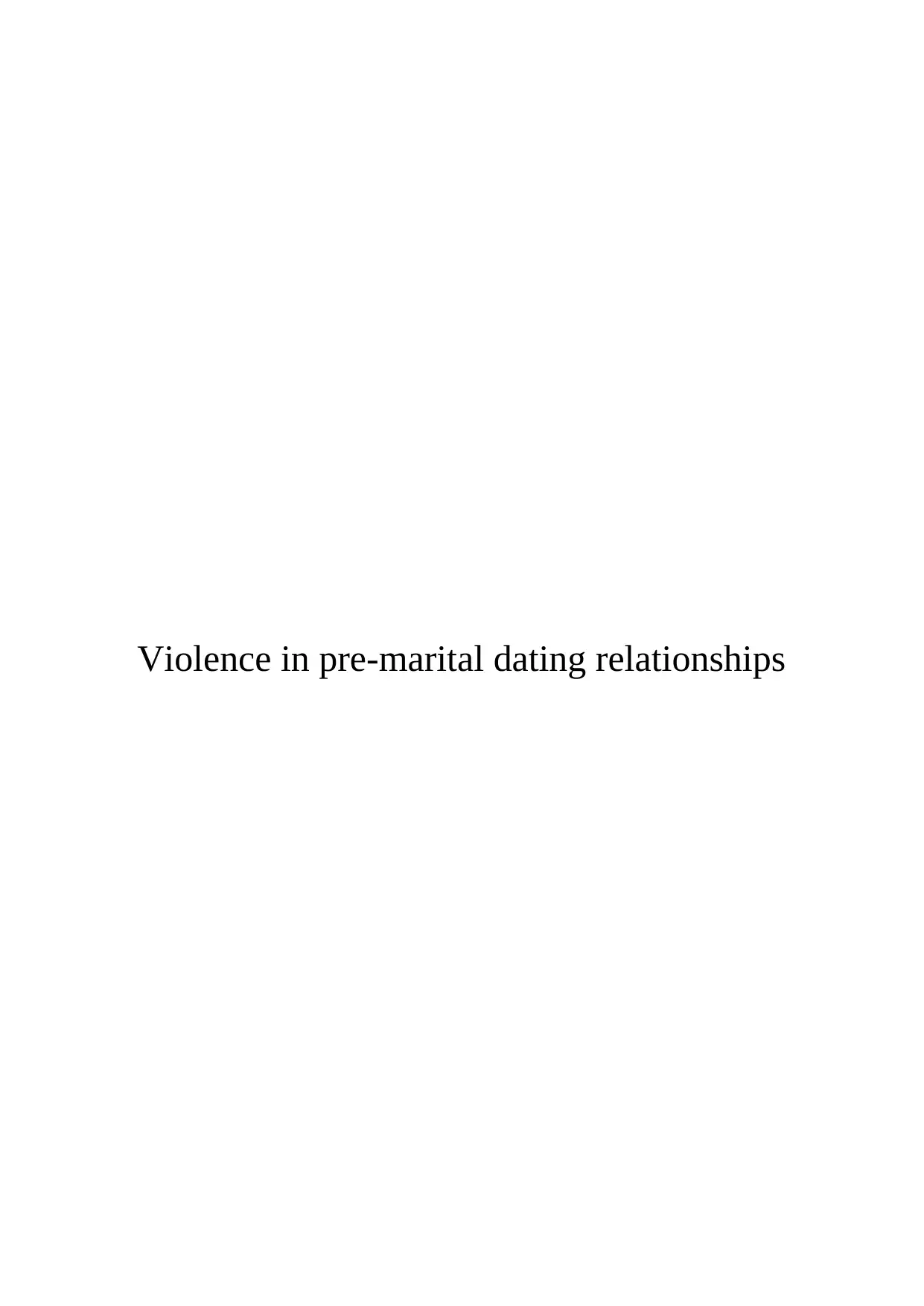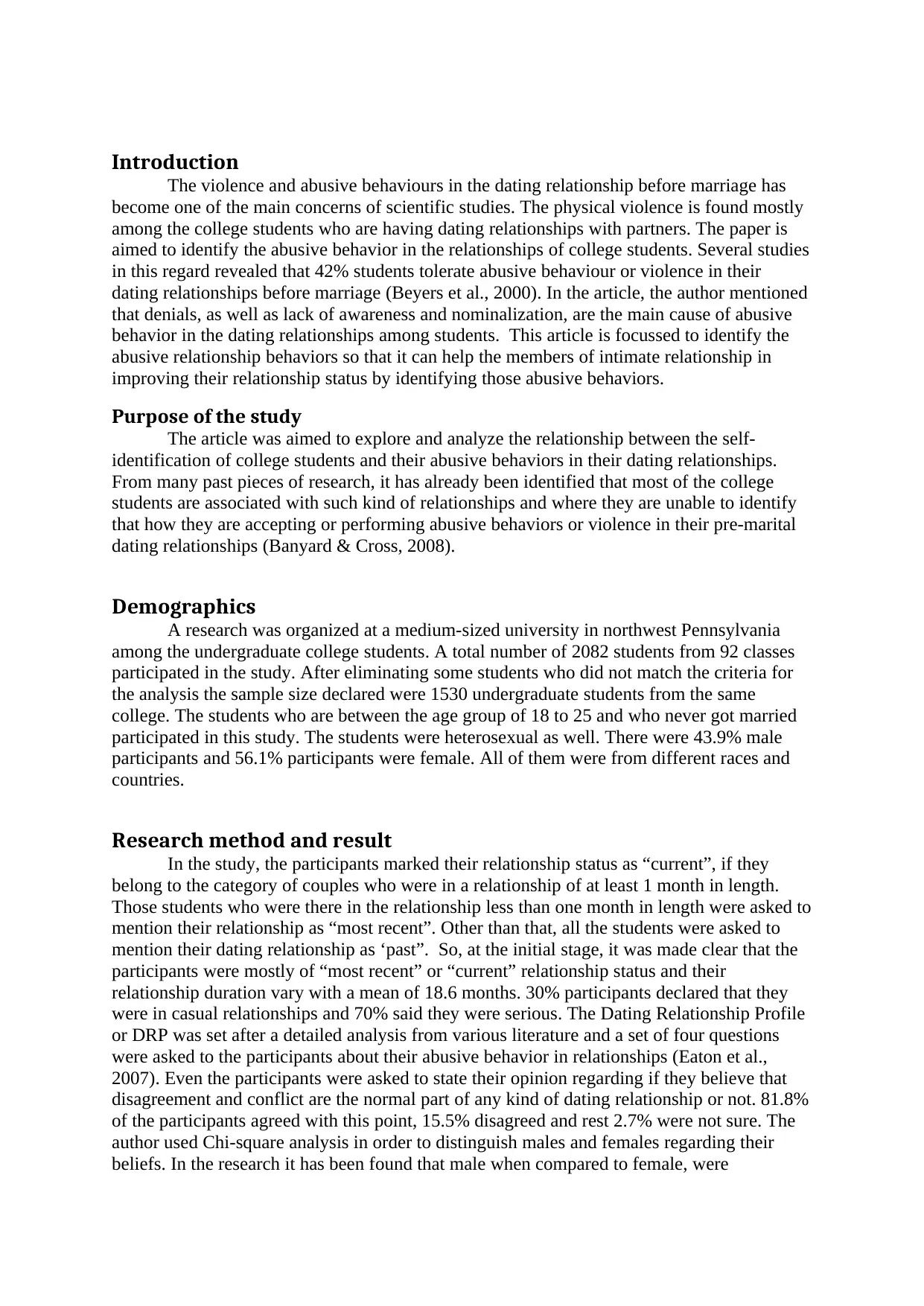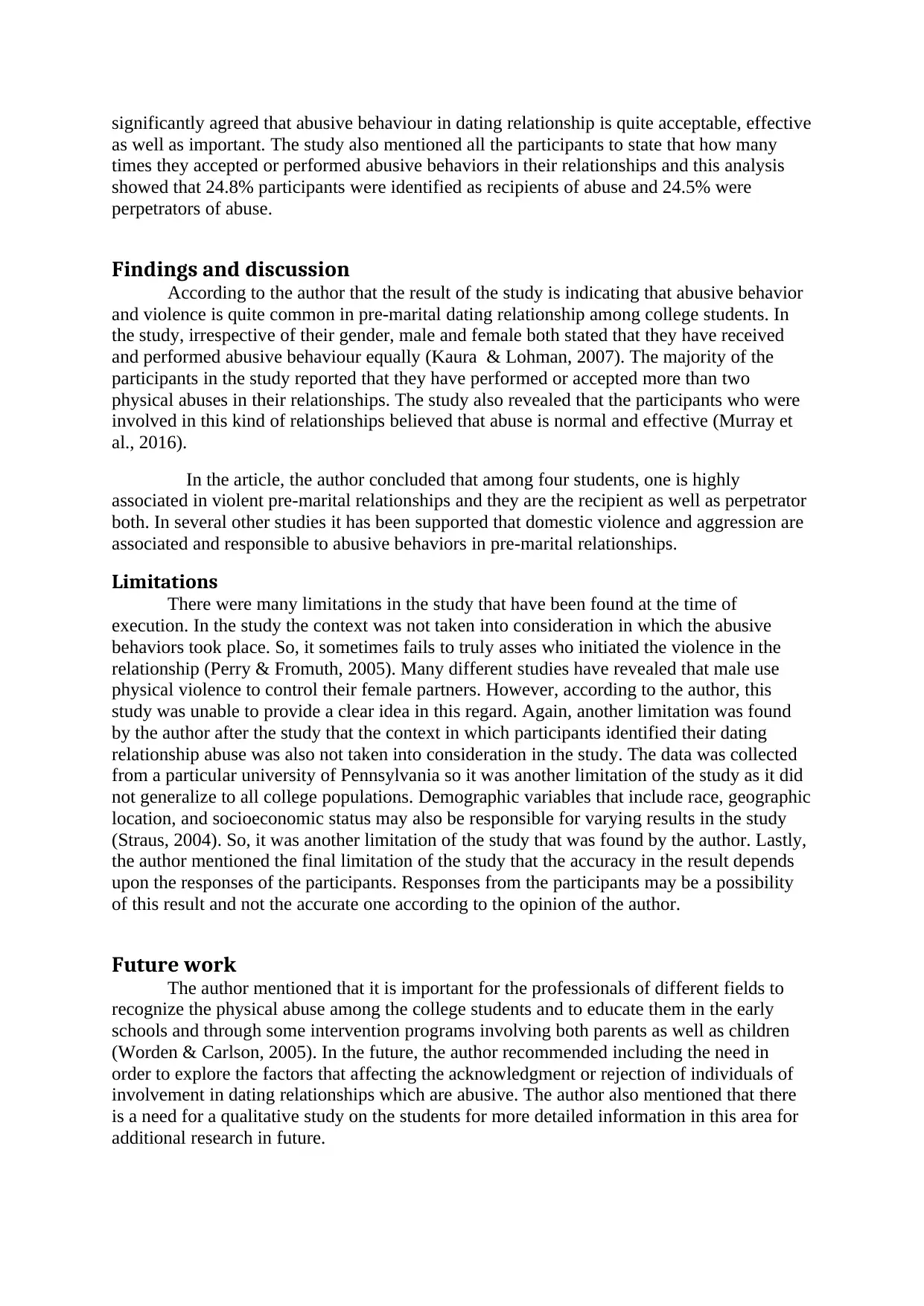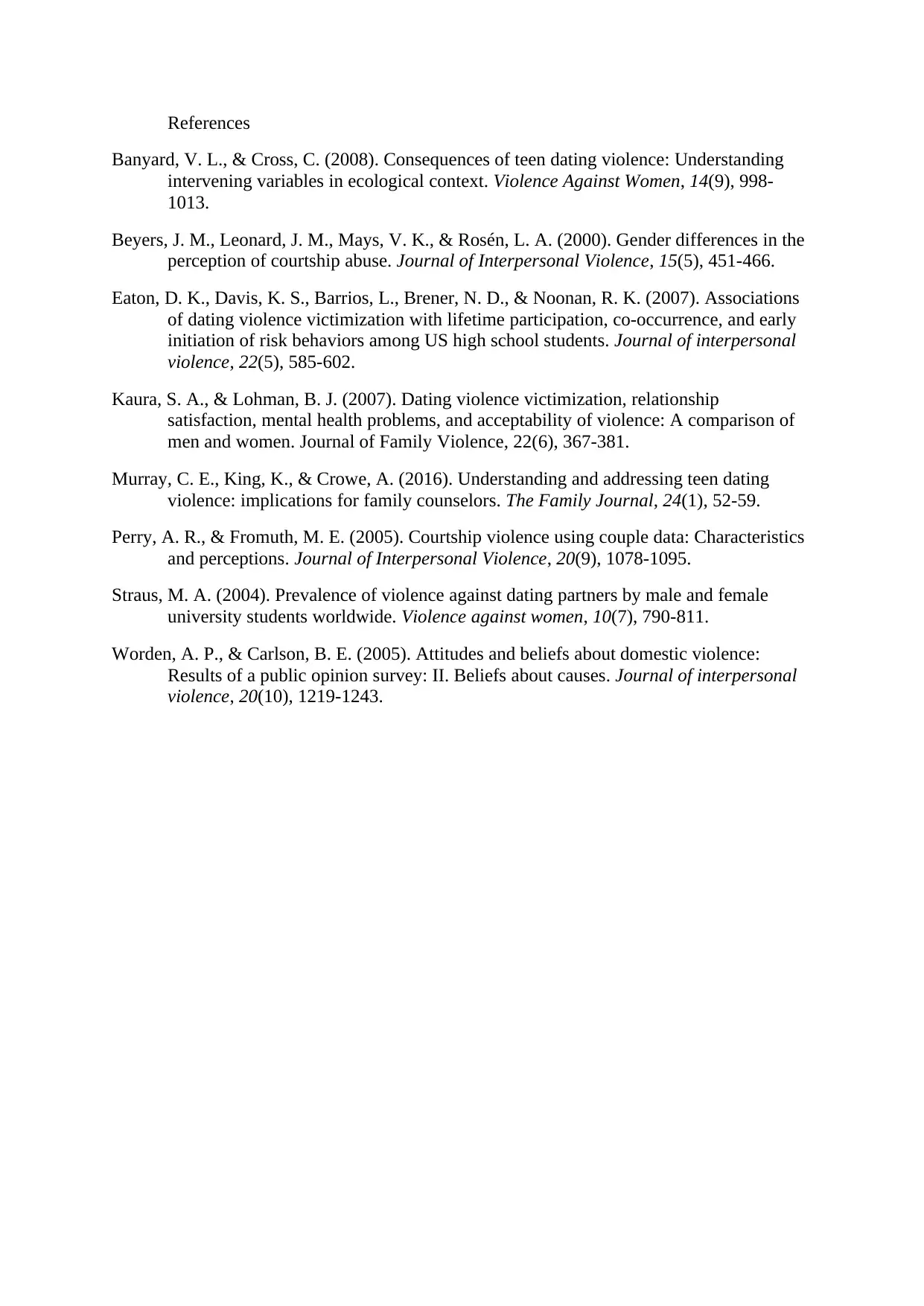Violence and Abuse in Pre-Marital Dating Relationships: A Report
VerifiedAdded on 2023/06/10
|5
|1564
|359
Report
AI Summary
This report examines the prevalence of violence and abusive behaviors within pre-marital dating relationships, focusing on college students. The study, conducted at a medium-sized university, involved 1530 undergraduate students aged 18-25, who were not married and were heterosexual. The research utilized the Dating Relationship Profile (DRP) to assess abusive behaviors, revealing that 24.8% of participants were recipients of abuse and 24.5% were perpetrators. The findings indicate that abusive behavior is common, with both males and females reporting equal involvement as both victims and perpetrators. The report highlights limitations, such as the lack of context in which abuse occurred and the study's confined demographic scope. The author emphasizes the need for professionals to recognize and address physical abuse through education and intervention programs, advocating for future research to explore factors influencing the acceptance or rejection of abusive relationships and the need for qualitative studies to gain more detailed information. The study references various sources to support its findings, including research on the consequences of teen dating violence, gender differences in the perception of courtship abuse, and the associations of dating violence with other risk behaviors.

Violence in pre-marital dating relationships
Paraphrase This Document
Need a fresh take? Get an instant paraphrase of this document with our AI Paraphraser

Introduction
The violence and abusive behaviours in the dating relationship before marriage has
become one of the main concerns of scientific studies. The physical violence is found mostly
among the college students who are having dating relationships with partners. The paper is
aimed to identify the abusive behavior in the relationships of college students. Several studies
in this regard revealed that 42% students tolerate abusive behaviour or violence in their
dating relationships before marriage (Beyers et al., 2000). In the article, the author mentioned
that denials, as well as lack of awareness and nominalization, are the main cause of abusive
behavior in the dating relationships among students. This article is focussed to identify the
abusive relationship behaviors so that it can help the members of intimate relationship in
improving their relationship status by identifying those abusive behaviors.
Purpose of the study
The article was aimed to explore and analyze the relationship between the self-
identification of college students and their abusive behaviors in their dating relationships.
From many past pieces of research, it has already been identified that most of the college
students are associated with such kind of relationships and where they are unable to identify
that how they are accepting or performing abusive behaviors or violence in their pre-marital
dating relationships (Banyard & Cross, 2008).
Demographics
A research was organized at a medium-sized university in northwest Pennsylvania
among the undergraduate college students. A total number of 2082 students from 92 classes
participated in the study. After eliminating some students who did not match the criteria for
the analysis the sample size declared were 1530 undergraduate students from the same
college. The students who are between the age group of 18 to 25 and who never got married
participated in this study. The students were heterosexual as well. There were 43.9% male
participants and 56.1% participants were female. All of them were from different races and
countries.
Research method and result
In the study, the participants marked their relationship status as “current”, if they
belong to the category of couples who were in a relationship of at least 1 month in length.
Those students who were there in the relationship less than one month in length were asked to
mention their relationship as “most recent”. Other than that, all the students were asked to
mention their dating relationship as ‘past”. So, at the initial stage, it was made clear that the
participants were mostly of “most recent” or “current” relationship status and their
relationship duration vary with a mean of 18.6 months. 30% participants declared that they
were in casual relationships and 70% said they were serious. The Dating Relationship Profile
or DRP was set after a detailed analysis from various literature and a set of four questions
were asked to the participants about their abusive behavior in relationships (Eaton et al.,
2007). Even the participants were asked to state their opinion regarding if they believe that
disagreement and conflict are the normal part of any kind of dating relationship or not. 81.8%
of the participants agreed with this point, 15.5% disagreed and rest 2.7% were not sure. The
author used Chi-square analysis in order to distinguish males and females regarding their
beliefs. In the research it has been found that male when compared to female, were
The violence and abusive behaviours in the dating relationship before marriage has
become one of the main concerns of scientific studies. The physical violence is found mostly
among the college students who are having dating relationships with partners. The paper is
aimed to identify the abusive behavior in the relationships of college students. Several studies
in this regard revealed that 42% students tolerate abusive behaviour or violence in their
dating relationships before marriage (Beyers et al., 2000). In the article, the author mentioned
that denials, as well as lack of awareness and nominalization, are the main cause of abusive
behavior in the dating relationships among students. This article is focussed to identify the
abusive relationship behaviors so that it can help the members of intimate relationship in
improving their relationship status by identifying those abusive behaviors.
Purpose of the study
The article was aimed to explore and analyze the relationship between the self-
identification of college students and their abusive behaviors in their dating relationships.
From many past pieces of research, it has already been identified that most of the college
students are associated with such kind of relationships and where they are unable to identify
that how they are accepting or performing abusive behaviors or violence in their pre-marital
dating relationships (Banyard & Cross, 2008).
Demographics
A research was organized at a medium-sized university in northwest Pennsylvania
among the undergraduate college students. A total number of 2082 students from 92 classes
participated in the study. After eliminating some students who did not match the criteria for
the analysis the sample size declared were 1530 undergraduate students from the same
college. The students who are between the age group of 18 to 25 and who never got married
participated in this study. The students were heterosexual as well. There were 43.9% male
participants and 56.1% participants were female. All of them were from different races and
countries.
Research method and result
In the study, the participants marked their relationship status as “current”, if they
belong to the category of couples who were in a relationship of at least 1 month in length.
Those students who were there in the relationship less than one month in length were asked to
mention their relationship as “most recent”. Other than that, all the students were asked to
mention their dating relationship as ‘past”. So, at the initial stage, it was made clear that the
participants were mostly of “most recent” or “current” relationship status and their
relationship duration vary with a mean of 18.6 months. 30% participants declared that they
were in casual relationships and 70% said they were serious. The Dating Relationship Profile
or DRP was set after a detailed analysis from various literature and a set of four questions
were asked to the participants about their abusive behavior in relationships (Eaton et al.,
2007). Even the participants were asked to state their opinion regarding if they believe that
disagreement and conflict are the normal part of any kind of dating relationship or not. 81.8%
of the participants agreed with this point, 15.5% disagreed and rest 2.7% were not sure. The
author used Chi-square analysis in order to distinguish males and females regarding their
beliefs. In the research it has been found that male when compared to female, were

significantly agreed that abusive behaviour in dating relationship is quite acceptable, effective
as well as important. The study also mentioned all the participants to state that how many
times they accepted or performed abusive behaviors in their relationships and this analysis
showed that 24.8% participants were identified as recipients of abuse and 24.5% were
perpetrators of abuse.
Findings and discussion
According to the author that the result of the study is indicating that abusive behavior
and violence is quite common in pre-marital dating relationship among college students. In
the study, irrespective of their gender, male and female both stated that they have received
and performed abusive behaviour equally (Kaura & Lohman, 2007). The majority of the
participants in the study reported that they have performed or accepted more than two
physical abuses in their relationships. The study also revealed that the participants who were
involved in this kind of relationships believed that abuse is normal and effective (Murray et
al., 2016).
In the article, the author concluded that among four students, one is highly
associated in violent pre-marital relationships and they are the recipient as well as perpetrator
both. In several other studies it has been supported that domestic violence and aggression are
associated and responsible to abusive behaviors in pre-marital relationships.
Limitations
There were many limitations in the study that have been found at the time of
execution. In the study the context was not taken into consideration in which the abusive
behaviors took place. So, it sometimes fails to truly asses who initiated the violence in the
relationship (Perry & Fromuth, 2005). Many different studies have revealed that male use
physical violence to control their female partners. However, according to the author, this
study was unable to provide a clear idea in this regard. Again, another limitation was found
by the author after the study that the context in which participants identified their dating
relationship abuse was also not taken into consideration in the study. The data was collected
from a particular university of Pennsylvania so it was another limitation of the study as it did
not generalize to all college populations. Demographic variables that include race, geographic
location, and socioeconomic status may also be responsible for varying results in the study
(Straus, 2004). So, it was another limitation of the study that was found by the author. Lastly,
the author mentioned the final limitation of the study that the accuracy in the result depends
upon the responses of the participants. Responses from the participants may be a possibility
of this result and not the accurate one according to the opinion of the author.
Future work
The author mentioned that it is important for the professionals of different fields to
recognize the physical abuse among the college students and to educate them in the early
schools and through some intervention programs involving both parents as well as children
(Worden & Carlson, 2005). In the future, the author recommended including the need in
order to explore the factors that affecting the acknowledgment or rejection of individuals of
involvement in dating relationships which are abusive. The author also mentioned that there
is a need for a qualitative study on the students for more detailed information in this area for
additional research in future.
as well as important. The study also mentioned all the participants to state that how many
times they accepted or performed abusive behaviors in their relationships and this analysis
showed that 24.8% participants were identified as recipients of abuse and 24.5% were
perpetrators of abuse.
Findings and discussion
According to the author that the result of the study is indicating that abusive behavior
and violence is quite common in pre-marital dating relationship among college students. In
the study, irrespective of their gender, male and female both stated that they have received
and performed abusive behaviour equally (Kaura & Lohman, 2007). The majority of the
participants in the study reported that they have performed or accepted more than two
physical abuses in their relationships. The study also revealed that the participants who were
involved in this kind of relationships believed that abuse is normal and effective (Murray et
al., 2016).
In the article, the author concluded that among four students, one is highly
associated in violent pre-marital relationships and they are the recipient as well as perpetrator
both. In several other studies it has been supported that domestic violence and aggression are
associated and responsible to abusive behaviors in pre-marital relationships.
Limitations
There were many limitations in the study that have been found at the time of
execution. In the study the context was not taken into consideration in which the abusive
behaviors took place. So, it sometimes fails to truly asses who initiated the violence in the
relationship (Perry & Fromuth, 2005). Many different studies have revealed that male use
physical violence to control their female partners. However, according to the author, this
study was unable to provide a clear idea in this regard. Again, another limitation was found
by the author after the study that the context in which participants identified their dating
relationship abuse was also not taken into consideration in the study. The data was collected
from a particular university of Pennsylvania so it was another limitation of the study as it did
not generalize to all college populations. Demographic variables that include race, geographic
location, and socioeconomic status may also be responsible for varying results in the study
(Straus, 2004). So, it was another limitation of the study that was found by the author. Lastly,
the author mentioned the final limitation of the study that the accuracy in the result depends
upon the responses of the participants. Responses from the participants may be a possibility
of this result and not the accurate one according to the opinion of the author.
Future work
The author mentioned that it is important for the professionals of different fields to
recognize the physical abuse among the college students and to educate them in the early
schools and through some intervention programs involving both parents as well as children
(Worden & Carlson, 2005). In the future, the author recommended including the need in
order to explore the factors that affecting the acknowledgment or rejection of individuals of
involvement in dating relationships which are abusive. The author also mentioned that there
is a need for a qualitative study on the students for more detailed information in this area for
additional research in future.
⊘ This is a preview!⊘
Do you want full access?
Subscribe today to unlock all pages.

Trusted by 1+ million students worldwide

Paraphrase This Document
Need a fresh take? Get an instant paraphrase of this document with our AI Paraphraser

References
Banyard, V. L., & Cross, C. (2008). Consequences of teen dating violence: Understanding
intervening variables in ecological context. Violence Against Women, 14(9), 998-
1013.
Beyers, J. M., Leonard, J. M., Mays, V. K., & Rosén, L. A. (2000). Gender differences in the
perception of courtship abuse. Journal of Interpersonal Violence, 15(5), 451-466.
Eaton, D. K., Davis, K. S., Barrios, L., Brener, N. D., & Noonan, R. K. (2007). Associations
of dating violence victimization with lifetime participation, co-occurrence, and early
initiation of risk behaviors among US high school students. Journal of interpersonal
violence, 22(5), 585-602.
Kaura, S. A., & Lohman, B. J. (2007). Dating violence victimization, relationship
satisfaction, mental health problems, and acceptability of violence: A comparison of
men and women. Journal of Family Violence, 22(6), 367-381.
Murray, C. E., King, K., & Crowe, A. (2016). Understanding and addressing teen dating
violence: implications for family counselors. The Family Journal, 24(1), 52-59.
Perry, A. R., & Fromuth, M. E. (2005). Courtship violence using couple data: Characteristics
and perceptions. Journal of Interpersonal Violence, 20(9), 1078-1095.
Straus, M. A. (2004). Prevalence of violence against dating partners by male and female
university students worldwide. Violence against women, 10(7), 790-811.
Worden, A. P., & Carlson, B. E. (2005). Attitudes and beliefs about domestic violence:
Results of a public opinion survey: II. Beliefs about causes. Journal of interpersonal
violence, 20(10), 1219-1243.
Banyard, V. L., & Cross, C. (2008). Consequences of teen dating violence: Understanding
intervening variables in ecological context. Violence Against Women, 14(9), 998-
1013.
Beyers, J. M., Leonard, J. M., Mays, V. K., & Rosén, L. A. (2000). Gender differences in the
perception of courtship abuse. Journal of Interpersonal Violence, 15(5), 451-466.
Eaton, D. K., Davis, K. S., Barrios, L., Brener, N. D., & Noonan, R. K. (2007). Associations
of dating violence victimization with lifetime participation, co-occurrence, and early
initiation of risk behaviors among US high school students. Journal of interpersonal
violence, 22(5), 585-602.
Kaura, S. A., & Lohman, B. J. (2007). Dating violence victimization, relationship
satisfaction, mental health problems, and acceptability of violence: A comparison of
men and women. Journal of Family Violence, 22(6), 367-381.
Murray, C. E., King, K., & Crowe, A. (2016). Understanding and addressing teen dating
violence: implications for family counselors. The Family Journal, 24(1), 52-59.
Perry, A. R., & Fromuth, M. E. (2005). Courtship violence using couple data: Characteristics
and perceptions. Journal of Interpersonal Violence, 20(9), 1078-1095.
Straus, M. A. (2004). Prevalence of violence against dating partners by male and female
university students worldwide. Violence against women, 10(7), 790-811.
Worden, A. P., & Carlson, B. E. (2005). Attitudes and beliefs about domestic violence:
Results of a public opinion survey: II. Beliefs about causes. Journal of interpersonal
violence, 20(10), 1219-1243.
1 out of 5
Related Documents
Your All-in-One AI-Powered Toolkit for Academic Success.
+13062052269
info@desklib.com
Available 24*7 on WhatsApp / Email
![[object Object]](/_next/static/media/star-bottom.7253800d.svg)
Unlock your academic potential
Copyright © 2020–2025 A2Z Services. All Rights Reserved. Developed and managed by ZUCOL.




